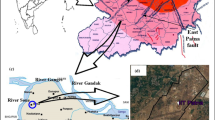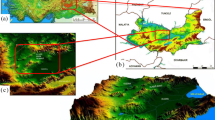Abstract
The seismic behaviour of a building on a liquefiable deposit is a complex interaction which involves quantifying both shaking induced damage and permanent ground deformation-related damage. In this paper the key parameters that influence both surface shaking and foundation settlements have been identified as the depth, thickness and liquefaction resistance of an equivalent liquefiable layer. These parameters can be used to develop an ‘equivalent soil profile’ that is analogous to the equivalent single degree-of-freedom that reduces the complexity of the dynamic response of a building into comparable and easily understood quantities. The equivalent soil profile is quantified independent of the seismic hazard, making it compatible with performance based design and assessment frameworks such that the building and soil profile can be directly assessed at different levels of seismic hazard. Several numerical studies are presented that demonstrate the influence of these key parameters on the ground surface shaking and foundation settlement. A set of criteria are proposed for classifying soil profiles into 22 different soil classes for regional loss assessment. An algorithm was developed for automatically fitting the equivalent soil profile to a cone penetration test trace and issues with the fitting are discussed. Field reconnaissance was undertaken to collect additional data to support existing datasets on the performance of buildings in Adapazari, during the 1999 Kocaeli, Turkey, earthquake (Mw = 7.4). The field case history data was used to investigate the correlation between the depth, thickness and liquefaction resistance of an equivalent liquefiable layer, on the extent of foundation permanent deformation. The case history data showed that in general a shallow, thick and weak liquefiable layer near the surface results in significant settlement but a lack of data for buildings on non-liquefiable deposits and the additional complexities involved with real buildings and soil deposits, meant that the trends observed in the idealised numerical models could not identified in the field case history data set.












Similar content being viewed by others
References
Abrahamson NA, Silva WJ, Kamai R (2014) Summary of the ASK14 Ground Motion Relation for Active Crustal Regions. Earthq Spectra 30(3):1025–1055. https://doi.org/10.1193/070913EQS198M
Akkar S, Sandıkkaya MA, Şenyurt M, Azari Sisi A, Ay BÖ, Traversa P, Douglas J, Cotton F, Luzi L, Hernandez B, Godey S (2013) Reference database for seismic ground-motion in Europe (RESORCE). Bull Earthq Eng 12(1):311–339. https://doi.org/10.1007/s10518-013-9506-8
Akkar S, Sandıkkaya MA, Bommer JJ (2014) Empirical ground-motion models for point- and extended-source crustal earthquake scenarios in Europe and the Middle East. Bull Earthq Eng 12(1):359–387
Bakir BS, Sucuoğlu H, Yilmaz T (2002) An Overview of Local Site Effects and the Associated Building Damage in Adapazari during the 17 August 1999 İzmit Earthquake. Bull Seismol Soc Am 92(1):509–526. https://doi.org/10.1785/0120000819
Bay JA, Cox BR (2001) Shear wave velocity profiling and liquefaction assessment of sites shaken by the 1999 Kocaeli, Turkey earthquake. Utah State University, Logan
Berkeley UC, Univ Brigham Young, UCLA, ZETAS, (2003) Documenting Incidents of Ground Failure Resulting from the August 17, 1999 Kocaeli. Technical report, Turkey Earthquake
Bertalot D, Brennan AJ (2015) Influence of initial stress distribution on liquefaction-induced settlement of shallow foundations. Géotechnique 65(5):418–428. https://doi.org/10.1680/geot.SIP.15.P.002
Bol E, Önalp A, Arel E, Sert S, Özocak A (2010) Liquefaction of silts: the Adapazari criteria. Bull Earthq Eng 8(4):859–873. https://doi.org/10.1007/s10518-010-9174-x
Bouckovalas GD, Tsiapas YZ, Zontanou VA, Kalogeraki CG (2017) Equivalent linear computation of response spectra for liquefiable sites: the spectral envelope method. J Geotech Geoenviron Eng 143(4):04016115. https://doi.org/10.1061/(ASCE)GT.1943-5606.0001625
Boulanger RW, Idriss IM (2014) CPT and SPT based liquefaction triggering procedures. Technical Report UCD/CGM-14/01
Boulanger RW, Idriss IM (2016) CPT-Based Liquefaction Triggering Procedure. Journal of Geotechnical and Geoenvironmental Engineering 142(2):04015065–11. https://doi.org/10.1061/(ASCE)GT.1943-5606.0001388
Boulanger RW, Ziotopoulou K (2017) PM4SAND (VERSION 3.1): A sand plasticity model for earthquake engineering applications (UCD/CGM-17/01)
Bouziou D, O’Rourke TD, Cubrinovski M, Henderson D (2015) Evaluation of ground deformations during the 2010–2011 Canterbury earthquake sequence. In: 7th International conference on earthquake geotechnical engineering, Christchurch
Bray JD, Macedo J (2017) 6th Ishihara lecture - Simplified procedure for estimating liquefaction-induced building settlement. Soil Dyn Earthq Eng 102:215–231. https://doi.org/10.1016/j.soildyn.2017.08.026
Bray JD, Baturay MB, Durgunoglu T, Onalp A, Sancio RB, Stewart JP, Ural D, Ansal A, Bardet JP (2000) Damage patterns and foundation performance in Adapazari. Earthq Spectra 16(S1):163–189
Bullock Z, Dashti S, Karimi Z, Liel A, Porter K, Franke K (2019a) Probabilistic models for residual and peak transient tilt of mat-founded structures on liquefiable soils. J Geotech Geoenviron Eng 145(2):04018108–14. https://doi.org/10.1061/(ASCE)GT.1943-5606.0002002
Bullock Z, Karimi Z, Dashti S, Porter K, Liel AB, Franke KW (2019b) A physics-informed semi-empirical probabilistic model for the settlement of shallow-founded structures on liquefiable ground. Géotechnique 69(5):406–419. https://doi.org/10.1680/jgeot.17.P.174
Danciu L, Şeşetyan K, Demircioglu M, Gülen L, Zare M, Basili R, Elias A, Adamia S, Tsereteli N, Yalçın H, Utkucu M, Khan MA, Sayab M, Hessami K, Rovida AN, Stucchi M, Burg JP, Karakhanian A, Babayan H, Avanesyan M, Mammadli T, Al-Qaryouti M, Kalafat D, Varazanashvili O, Erdik M, Giardini D (2017) The 2014 Earthquake Model of the Middle East: seismogenic sources. Bull Earthq Eng 16(8):3465–3496. https://doi.org/10.1007/s10518-017-0096-8
EC 8 (2004) Eurocode 8: Design of structures for earthquake resistance—Part 1: General rules, seismic actions and rules for buildings
Giardini D, Danciu L, Erdik M, Sesetyan K, Demircioglu M, S A, Gülen L, Zare M (2016) Seismic Hazard Map of the Middle East 10.12686/a1
Gómez-Martinez F, Millen MDL, Costa PA, Romão X (2020) Estimation of the potential relevance of differential settlements in earthquake-induced liquefaction damage assessment. Eng Struct 211:110232. https://doi.org/10.1016/j.engstruct.2020.110232
Green AR, Cubrinovski M, Allen J, Ashford S, Bowman E, Bradley B, Cox B, Hutchinson TC, Kavazanjian E, Orense R, O’Rourke TD, Pender MJ, Quigley M, Wotherspoon L (2010) Geotechnical Reconnaissance of the 2010 Darfield (New Zealand) Earthquake pp 1–180
Green RA, Cubrinovski M, Cox B, Wood C, Wotherspoon L, Bradley BA, Maurer B (2014) Select liquefaction case histories from the 2010–2011 Canterbury earthquake sequence. Earthq Spectra 30(1):131–153. https://doi.org/10.1193/030713EQS066M
Henderson D (2013) The Performance of House Foundations in the Canterbury Earthquakes pp 1–448, https://ir.canterbury.ac.nz/handle/10092/8741
Ishihara K (1985) Stability of natural deposits during earthquakes. In: 11th International conference on soil mechanics and foundation engineering
ITASCA (2017) FLAC2D - Fast Lagrangian Analysis of Continua, Version. 8.0. Minneapolis: Itasca. https://www.itascacg.com/software/flac
Iwasaki T, Arakawa T, Tokida K (1984) Simplified procedures for assessing soil liquefaction during earthquakes. J Soil Dyn Earthq Eng 3(1):49–58. https://doi.org/10.1016/0261-7277(84)90027-5
Karamitros DK, Bouckovalas GD, Chaloulos YK (2013) Seismic settlements of shallow foundations on liquefiable soil with a clay crust. Soil Dyn Earthq Eng 46(1):64–76. https://doi.org/10.1016/j.soildyn.2012.11.012
Karatzia XA, Mylonakis G, Bouckovalas GD (2017) Equivalent-linear Dynamic Stiffness of Surface Footings on Liquefiable Soil. In: COMPDYN, pp 1–15, https://2017.compdyn.org/proceedings/pdf/18213.pdf
LIQUEFACT (2019) Liquefaction Assessment and mitigation of Liquefaction potential across Europe: a holistic approach to protect structures/infrastructure for improved resilience to earthquake-induced Liquefaction disasters, H2020-DRA-2015, GA no. 700748
Liu L, Dobry R (1997) Seismic response of shallow foundation on liquefiable sand. J Geotech Geoenviron Eng 123(6):557–567. https://doi.org/10.1061/(ASCE)1090-0241(1997)123:6(557)
Lu CW (2017) A simplified calculation method for liquefaction- induced settlement of shallow foundation. J Earthquake Eng 00(00):1–21. https://doi.org/10.1080/13632469.2016.1264327
Macedo J, Bray JD (2018) Key Trends in Liquefaction-Induced Building Settlement. Journal of Geotechnical and Geoenvironmental Engineering 144(11):04018076–15. https://doi.org/10.1061/(ASCE)GT.1943-5606.0001951
MBIE, EQC (2020) New Zealand Geotechnical Database. https://www.nzgd.org.nz/
Mejia LH, Dawson EM (2006) Earthquake deconvolution for FLAC. In: 4th International symposium of numerical modelling in geomechanics, Minneapolis
Meyerhof GG, Hanna AM (1978) Ultimate bearing capacity of foundations on layered soils under inclined load. Can Geotech J 15(4):565–572. https://doi.org/10.1139/t78-060
Millen MDL, Quintero J (2019) liquepy https://pypi.org/project/liquepy/
Millen MDL, Ferreira C, Gerace A, Viana da Fonseca A (2019) Simplified equivalent soil profiles based on liquefaction performance for shallow-founded structures. In: 7th International conference on earthquake geotechnical engineering, pp 1–8
Millen MDL, Rios S, Quintero J, Viana da Fonseca A (2020) Prediction of time of liquefaction using kinetic and strain energy. Soil Dyn Earthq Eng 128:105898. https://doi.org/10.1016/j.soildyn.2019.105898
Modoni G, L SR, Paolella L, Rasulo A, D’Apuzzo M, Jones K, Antonietta M, Lai C, Bozzoni F, Meisina C, Viana da Fonseca A, Millen MDL, Rios S, Ferreira C, Kosič K, Dolšek M, Logar J, Oztoprak S, Bozbey I, Oser C, Sargin S, Aysal N, Ozcep F, Kelesoglu KM, Flora A, Bilotta E, Fioravante V, Meslem A (2017) Full and detailed case study report of the application of the risk/resilience assessment toolbox for the selected past EILD cases. LIQUEFACT Deliverable 73 Assessment and mitigation of liquefaction potential across Europe: a holistic approach to protect structures / infrastructures for improved resilience to earthquake induced liquefaction disasters
Ntritsos N, Cubrinovski M (2020) A CPT-based effective stress analysis procedure for liquefaction assessment. Soil Dyn Earthq Eng 131:106063. https://doi.org/10.1016/j.soildyn.2020.106063
Ordaz M, A SGM (2017) R-CRISIS Validation and Verification Document
Sancio R, Bray JD, Durgunoglu T, Onalp A (2004) Performance of buildings over liquefiable ground in Adapazari, Turkey. In: 13th World conference on earthquake engineering
Sancio RB (2003) Ground Failure and Building Performance In Adapazari, Turkey. PhD thesis, Universtiy of California
Sancio RB, Bray JD, Riemer MF, Durgunoglu T (2003) An assessment of the liquefaction susceptibility of Adapazari silt. In: 2003 Pacific conference on earthquake engineering. Christchurch
Shahir H, Pak A (2010) Estimating liquefaction-induced settlement of shallow foundations by numerical approach. Comput Geotech 37(3):267–279. https://doi.org/10.1016/j.compgeo.2009.10.001
Tsiapas YZ, Bouckovalas GD (2018) Numerical noise effects and filtering in liquefiable site response analyses. In: Numerical Methods in Geo Eng IX, pp 1–8
van Ballegooy S, Malan P, Lacrosse V, Jacka ME, Cubrinovski M, Bray JD, O’Rourke TD, Crawford SA, Cowan H (2019) Assessment of Liquefaction-Induced Land Damage for Residential Christchurch. Earthq Spectra 30(1):31–55. https://doi.org/10.1193/031813EQS070M
Vardanega PJ, Bolton MD (2013) Stiffness of clays and silts: normalizing shear modulus and shear strain. J Geotech Geoenviron Eng 139(9):1575–1589. https://doi.org/10.1061/(ASCE)GT.1943-5606.0000887
Viana da Fonseca A, Millen M, Romão X, Quintero J, Rios S, Ferreira C, Panico F, Azeredo C, Pereira N, Logar J, Oblak M, Dolsek M, Kosic M, Kuder S, Logar M, Oztoprak S, Kelesoglu MK, Sargin S, Oser C, Bozbey I, Flora A, Billota E, Prota A, Ludovico M, Chiaradonna A, Modoni G, Paolella L, Spacagna R, Lai C, Shinde S, Bozzoni F (2018) DELIVERABLE D3.2 Methodology for the liquefaction fragility analysis of critical structures and infrastructures: description and case studies. Technical Report D3.2. http://www.liquefact.eu
Yoshida N, Tokimatsu K, Yasuda S, Kokusho T, Okimura T (2001) Geotechnical aspects of damage in Adapazari City during 1999 Kocaeli, Turkey earthquake. Soils Found 41(4):25–45. https://doi.org/10.3208/sandf.41.4_25
Youd TL, Idriss IM, Andrus RD, Arango I, Castro G, Christian JT, Dobry R, Finn L, Harder LFJ, Hynes ME, Ishihara K, Mitchell JK, Moriwaki Y, Power MS, Robertson PK, Seed RB, Stokoe KH (2001) Liquefaction resistance of soils: summary report from the 1996 NCEER and 1998 NCSEER/NSF workshops on evaluation of liquefaction resistance of soils. J Geotech Geoenviron Eng 127(4):297–313
Zhang G, Robertson PK, Brachman RWI (2002) Estimating liquefaction-induced ground settlements from CPT for level ground. Can Geotech J 39(5):1168–1180. https://doi.org/10.1139/t02-047
Acknowledgements
This paper was produced as part of the LIQUEFACT project (“Assessment and mitigation of liquefaction potential across Europe: a holistic approach to protect structures/infrastructures for improved resilience to earthquake-induced liquefaction disasters”) has received funding from the European Union’s Horizon 2020 research and innovation programme under Grant Agreement No. GAP-700748. UPorto team was also financially supported by UIDB/04708/2020 and UIDP/04708/2020 of CONSTRUCT - Institute of R&D in Structures and Construction funded by the national funds through the FCT/MCTES (PIDDAC). Istanbul University-Cerrahpasa would like to thank Adapazari and Sakarya Municipalities for sharing their data and for their tremendous support.
Author information
Authors and Affiliations
Corresponding author
Additional information
Publisher's Note
Springer Nature remains neutral with regard to jurisdictional claims in published maps and institutional affiliations.
Electronic supplementary material
Below is the link to the electronic supplementary material.
Rights and permissions
About this article
Cite this article
Millen, M., Viana da Fonseca, A., Quintero, J. et al. Site classification using equivalent soil profiles for building-liquefaction interaction. Bull Earthquake Eng 19, 3987–4012 (2021). https://doi.org/10.1007/s10518-020-00967-0
Received:
Accepted:
Published:
Issue Date:
DOI: https://doi.org/10.1007/s10518-020-00967-0




